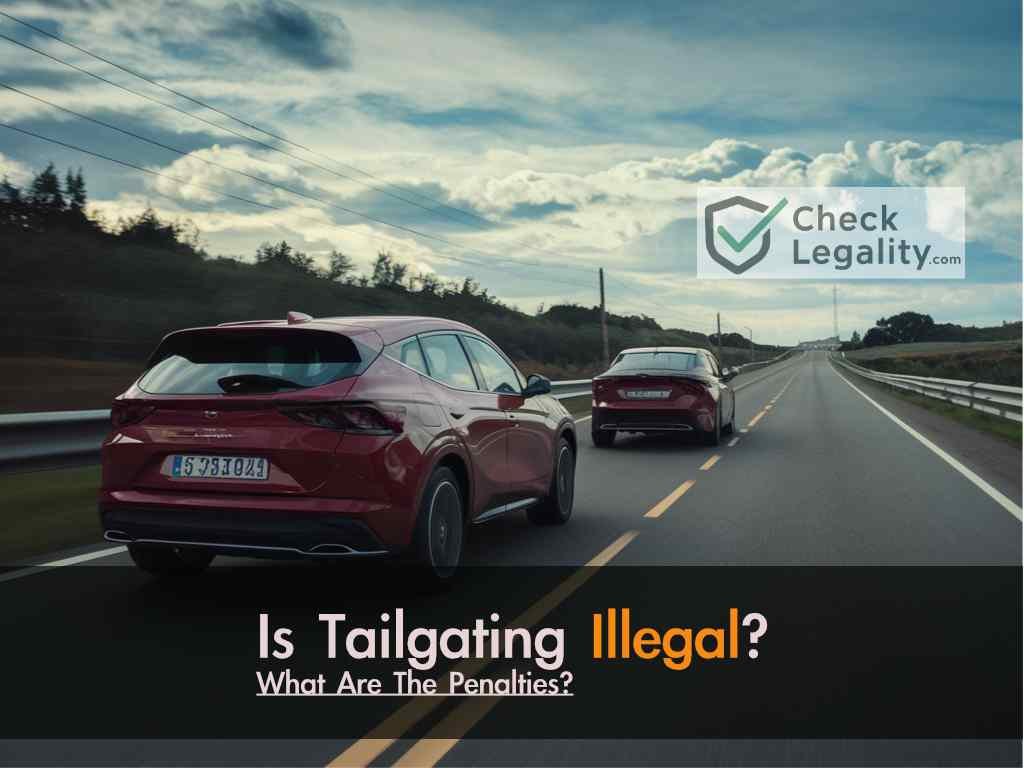Quick Legality Answer
Is Tailgating Illegal? It Depends on Your State, But It’s Always Dangerous
Tailgating is a dangerous driving habit that can lead to rear-end collisions, road rage incidents, and a loss of control. While no single federal law explicitly outlaws tailgating, many states have laws against following too closely or reckless driving that can encompass tailgating behavior.
This article explored the dangers of tailgating, the challenges of enforcing tailgating laws, and the importance of maintaining a safe following distance. We also discussed how the legal implications of tailgating vary from state to state, with some states having stricter penalties for aggressive driving behaviors that include tailgating.
Is Tailgating Illegal?
Traffic safety is a shared responsibility. One crucial safety aspect while driving is observing a safe following distance from the vehicle in front of you. However, a common problem on the road is tailgating, which occurs when a driver follows another vehicle too closely.
Going back to the “Is tailgating illegal?” question, it’s clear that tailgating significantly increases the risk of accidents and creates a dangerous situation for everyone involved. Here’s why:
- Reduced Reaction Time: The primary danger of tailgating lies in the significantly reduced reaction time it allows for the following driver. If the car in front brakes suddenly due to an unexpected hazard or traffic slowdown, the tailgater has much less time to react and avoid a collision. This is especially true at higher speeds, where stopping distances are longer.
- Chain Reaction of Collisions: A single tailgating incident can easily trigger a domino effect. If the first car slams on the brakes due to a tailgater, the following car might not have enough time to stop either, causing a multi-vehicle pileup. These chain reaction accidents can result in serious injuries and even fatalities.
- Escalation of Road Rage: The frustration and pressure caused by tailgating can lead to aggressive driving behaviors like swerving, yelling, or even brake checking. This escalating tension creates a chaotic and unpredictable environment on the road, putting everyone at risk.
The Prevalence of Tailgating
Unfortunately, tailgating is a widespread problem. Studies by the National Highway Traffic Safety Administration (NHTSA) show that a significant percentage of drivers admit to tailgating on a regular basis. This highlights the importance of understanding the dangers of the “Is tailgating illegal?” question and the legal implications in different jurisdictions.
Legality of Tailgating: A State-by-State Analysis:

Checking the Legality of tailgating, while there’s no single federal law against tailgating, many states have laws that can encompass this behavior. We’ll now go in them below.
Is Tailgating illegal?- Maintaining Space for Safety
Since tailgating significantly reduces reaction time and increases the risk of accidents, maintaining a safe following distance is paramount. This section will explore how to determine a safe following distance and discuss best practices to avoid tailgating altogether.
The Importance of Safe Following Distances:
Leaving enough space between your vehicle and the car in front allows you to react safely to unforeseen situations on the road. This buffer zone provides precious seconds to brake smoothly if the lead vehicle slows down unexpectedly.
Here’s why maintaining a safe following distance is crucial:
- Increased Reaction Time: With a safe following distance, you have more time to perceive a hazard, react by applying the brakes, and bring your vehicle to a complete stop without causing a collision with the car in front.
- Improved Maneuverability: A safe following distance allows you to maneuver your vehicle if necessary, avoiding obstacles or hazards the lead driver might encounter.
- Reduced Stress: Knowing you have enough space to react calmly in case of sudden braking can significantly reduce driving stress and contribute to a more enjoyable and focused driving experience.
Determining a Safe Following Distance:
There isn’t a one-size-fits-all answer to how far you should follow the car in front of you. The safe following distance depends on several factors, including:
- Speed: The faster you’re driving, the greater the following distance you need to maintain. This is because stopping distances increase significantly at higher speeds.
- Weather Conditions: Adverse weather conditions like rain, snow, or fog can affect visibility and road surface conditions. In such situations, increasing your following distance is essential to allow for extra stopping time.
- Traffic Conditions: Heavy traffic congestion requires a closer following distance, but it’s still important to maintain a safe buffer zone to avoid rear-end collisions due to sudden braking by surrounding vehicles.
Following Distance Techniques:

Here are two common methods for determining a safe following distance:
- The 3-Second Rule: This widely recognized guideline suggests maintaining a following distance of at least three seconds behind the vehicle in front of you. To implement this rule, choose a fixed point (like a sign or a lane marking) on the road ahead, and then count the seconds it takes for your vehicle to reach that point after the lead vehicle passes it. You follow too closely if you reach the point in less than three seconds.
- The Time-Gap Method: This approach estimates the distance between your vehicle and the lead vehicle in car lengths. A common recommendation is to maintain a following distance of one-second gap per car length. For example, if you estimate the distance to the car in front of you to be two car lengths, you should aim for a two-second following distance.
Remember: These methods are general guidelines, and adjusting your following distance is crucial based on the specific driving conditions you encounter.
Is Tailgating Illegal? – Safe Driving Practices to Avoid Tailgating:
By incorporating these practices into your driving routine, you can significantly reduce the risk of being involved in a tailgating incident:
- Maintain Awareness of Your Surroundings: Pay attention to the vehicles around you and avoid distractions that can impair your ability to judge distances and react quickly.
- Use Cruise Control on Highways: Cruise control can help you maintain a consistent speed and a safe following distance, especially on long highway stretches.
- Avoid Distractions: Put down your phone, don’t eat while driving, and minimize distractions that can take your focus away from the road.
- Be Courteous: Maintain a courteous and predictable driving style. Avoid sudden lane changes or aggressive maneuvers that might provoke other drivers to tailgate you.
- Leave Early: Allow yourself ample travel time to avoid the stress of rushing and feeling pressured to speed up or tailgate the car in front of you.
- If You’re Being Tailgated: If you notice someone tailgating you, stay calm and avoid reacting impulsively. Consider changing lanes if it’s safe and allow the tailgater to pass. Don’t brake check or engage in aggressive maneuvers that could escalate the situation.
Following these tips and maintaining a safe following distance can contribute to a safer driving environment for yourself and others on the road.
Legal Implications of Tailgating: A State-by-State Analysis
The “is tailgating illegal?” question might seem minor, but the consequences of such action can be severe. While there’s no single federal law against tailgating, many states have laws that address this dangerous behavior. Understanding the legal implications of tailgating in your state and others you frequently drive through can be a strong deterrent and encourage safe driving practices.
Unlike some traffic violations, like speeding, no overarching federal law explicitly outlaws tailgating. Traffic laws in the United States are primarily established and enforced at the state level, which means that the specific laws and penalties for tailgating can vary significantly from state to state.
Tailgating as Reckless Driving or Following Too Closely:
Many states address tailgating through laws against reckless driving or following too closely. These laws are often broadly defined and give law enforcement officers discretion in determining whether a driver’s following distance constitutes a violation.
Here’s a closer look at how some states address tailgating:
- California: California Vehicle Code (CVC) Section 21703 prohibits following another moving vehicle “more closely than is reasonable and prudent, having due regard for the speed of such vehicle and the traffic upon and the condition of the highway.” A violation of this law can be a misdemeanor punishable by a fine and a point on your driving record.
- Florida: Florida Statute § 316.183(1) defines following too closely as “maintaining an unsafe following distance from the motor vehicle ahead.” The following distance is not explicitly defined, leaving it to the officer’s discretion. A first offense for following too closely in Florida is a non-criminal violation punishable by a fine.
- Texas: Texas Transportation Code § 545.06 defines reckless driving as operating a motor vehicle in a manner that demonstrates a disregard for the safety of others. Tailgating can be considered reckless driving under this law, and a conviction can result in a fine of up to $2,000 and jail time of up to 180 days.
Important Note: These are just a few examples, and it’s crucial to research the specific tailgating laws in your state and any states you frequently travel through. The official traffic codes for each state are on their government websites.
Tailgating and Aggressive Driving Laws:
In addition to following too closely or reckless driving laws, some states have additional statutes that target aggressive driving behaviors. Tailgating, combined with other aggressive maneuvers like flashing lights or swerving, can violate these laws.
Here’s an example:
- Virginia Code § 46.2-814.1 defines aggressive driving as operating a motor vehicle in a way that is “careless and creates an unreasonable risk of collision.” Tailgating combined with other aggressive behaviors can be considered a violation of this law, which is punishable by a fine of up to $2,500 and potential driver’s license suspension.
Case Law and Precedents:
Court decisions and legal precedents can also influence the interpretation of tailgating laws. These rulings can help establish specific criteria for determining what constitutes an unsafe following distance in different scenarios.
The Importance of Consulting a Lawyer:
Traffic laws can be complex, and interpretations can vary depending on the specific circumstances of a tailgating incident. If you’re involved in an accident caused by tailgating or receive a ticket for following too closely, consulting with a lawyer experienced in traffic violations is highly recommended.
They can analyze the details of your case, the applicable state laws, and potential defenses to help you effectively navigate the legal process.
Challenges in Enforcing Tailgating Laws:
Several factors make enforcing tailgating laws difficult:
- Subjectivity of Following Distances: Unlike speeding violations, where a radar gun clearly measures the distance, there’s no universally accepted objective measure for a safe following distance. Police officers often rely on their own judgment and estimation of following distances during traffic stops.
- Driver Discretion and Self-Reporting: In many cases, officers might ask drivers involved in a suspected tailgating incident to estimate their following distance. These self-reported distances can be subjective and unreliable.
- Focus on More Evident Violations: Law enforcement often prioritizes apprehending drivers who are committing more easily identifiable traffic violations like speeding or running red lights. Tailgating, while equally dangerous, can be more challenging to definitively enforce.
Conclusion: Is Tailgating Illegal?
It may not be illegal in your state, but universally, it’s a dangerous driving behavior. Creating a safe driving culture requires a collective effort from all road users. Understanding the dangers of tailgating, following safe driving practices like maintaining a safe following distance, and being aware of the legal implications can significantly contribute to a safer and more courteous driving environment.


